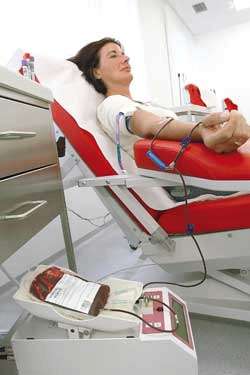Blood Donation procedure - facts, donor requirements

What is Blood donation and Definition
Blood Donation is the procedure of withdrawing BLOOD to prepare and use for BLOOD TRANSFUSION. Volunteer donors provide all human blood and blood products used for transfusions. According to the American Association of Blood Banks, 8 million Americans donate 15 million units of blood each year. Because blood banks separate the majority of donated blood into component blood products, one unit of donated whole blood can meet multiple needs.
The body replaces lost fluid volume (PLASMA) within 24 hours of donation, and erythrocytes (red blood cells) and other blood cells in six to eight weeks. A healthy adult may donate one unit of whole blood every eight weeks. There is no cost for donating blood, and there is very minimal risk. A person cannot contract HEPATITIS, HIV/AIDS, or other infectious diseases through the process of donating blood.
Donor Requirements
In the United States, individual states and blood banks establish regulations and procedures to determine donor eligibility. In general, a prospective donor must
- be 17 years of age or older
- pass a preliminary health screening that identifies potential health risks for the donor or for recipients of the donor’s blood
- weigh 100 pounds or more
Health screening questions aim to reveal behaviors or practices that carry a risk for INFECTION with diseases such as hepatitis and HIV/AIDS. Such behaviors include intravenous DRUG use and sex with multiple partners. In 1998, US blood banks also began screening prospective donors for possible exposure to variant Creutzfeldt-Jakob disease (VCJD), the human illness resulting from bovine spongiform encephalopathy (“mad cow” disease). Numerous health conditions may preclude an individual from donating blood; blood banks refer to these exclusions as deferrals.
The Blood Donation Procedure
The total blood donation process takes about 45 minutes to an hour, about 20 minutes of which is the actual blood withdrawal (called PHLEBOTOMY). Once the prospective donor clears the health screening, he or she sits in a reclining chair to be comfortable for the donation process. The technician cleanses the inner arm at the elbow with an antiseptic and puts a tourniquet briefly around the upper arm to cause the veins to engorge. The technician then inserts a sterile needle, connected to collection tubing and bag, into one of the veins and releases the tourniquet.
The technician may ask the person to periodically squeeze an object to help move blood through the VEIN during collection. After blood fills the collection bag (one unit), the technician withdraws the needle and places pressure over the puncture site for several minutes to suppress any bleeding, then applies a bandage that should stay in place for two to four hours. The person moves to a resting area, usually to have a drink of juice or water and a snack, then may leave when he or she feels comfortable. The risks associated with donating blood are very minor and may include bleeding, bruising, or discomfort at the needle insertion site.
Donor Blood Distribution and Use
Most donated blood goes to centralized blood banks for distribution to hospitals, which administer it to anyone who needs it. Two exceptions are
- autologous donation (BLOOD AUTODONATION), in which an individual donates blood for his or her own transfusion such as for a planned major surgery
- directed donation, in which an individual asks that others donate blood on his or her behalf and specified use, such as following a major trauma or unanticipated major surgery
Blood banks generally cannot use blood not used for self-transfusion (autologous donation) or not administered to the intended recipient (directed donation) for general transfusions and must instead throw it away. Some blood banks screen and process autologous donations differently from general donations, making autologous donations unacceptable for general use. Other blood banks handle autologous and general donations the same and have procedures for donors to authorize, at the time of donation, other use of their blood under such circumstances to avoid unnecessary waste of such a valuable resource. Though blood banks screen and process directed donations the same as general donations, many health experts are concerned that donors may not be forthcoming during the health screening process, raising the risk for the blood to carry pathogens. The tests blood banks run on each unit of donated blood may not detect the presence of certain infections, making accurate health screening essential.
See also BONE MARROW DONATION; CREUTZFELDTJAKOB DISEASE (CJD); HEMOCHROMATOSIS; HEMAPHERESIS.